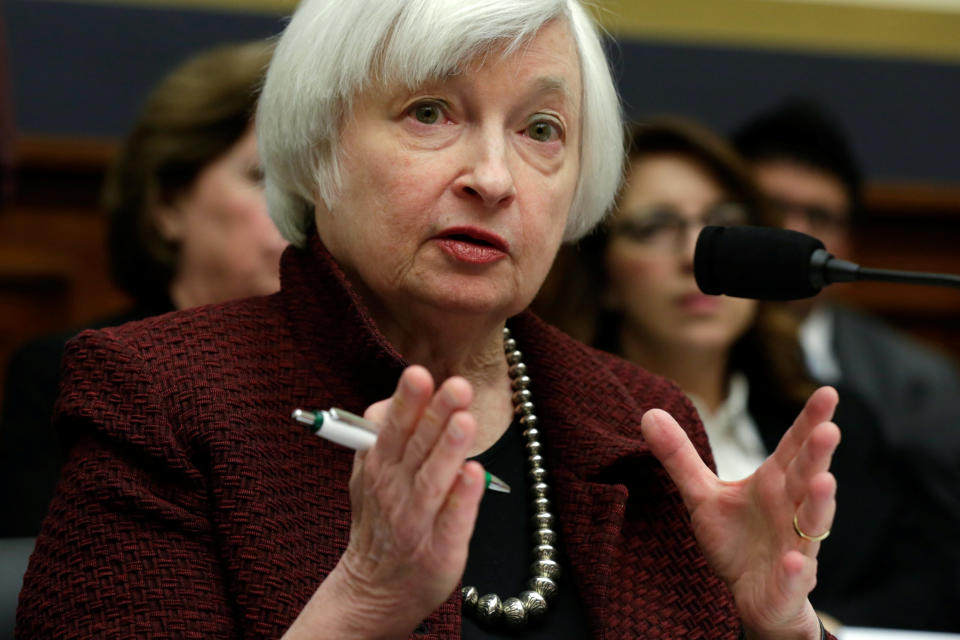Claims and starts — What you need to know in markets on Thursday
After a couple of busy days for markets headlines, Thursday should be relatively calmer with the economic and earnings calendars both a bit lighter.
The headline data out Thursday will drop at 8:30 a.m. ET, when both initial jobless claims and the monthly reads on housing starts and building permits will hit the tape.
Initial claims are expected to total 245,000 while housing starts should be flat over the prior month. Building permits are expected to rise 0.2%.
On the earnings front, headline reports out Thursday are expected from Wendy’s (WEN), MGM (MGM), Tempur Sealy (TPX), Zoetis (ZTS), and DaVita (DVA).

‘Trump Bump’ confirmed? That depends.
After Donald Trump was elected president, markets took off while business and consumer confidence skyrocketed. The so-called “Trump Bump” that both markets and the economy enjoyed fueled stocks to new records in December and into the first weeks of 2017.
But as we transition into the second half of the new year’s first quarter, the lingering question is whether these surveys and market moves will translate into real changes in the economy.
On Wednesday, an initial round of data indicated that these so-called “soft data” may be translating into the “hard data” that see the US economy actually grow faster as a result of new or anticipated policies from the Trump administration.
Both inflation data and retail sales figures for January came in better than expected on Wednesday. Headline consumer prices rose by the most since March 2012. Retail sales topped expectations for the fifth straight month and December’s results — which capture the heart of the all-important holiday sales season — were revised higher.
“Net-net, all things consumer show the economy is starting the year off with a bang,” Chris Rupkey, chief financial economist at MUFG, wrote after Wednesday’s data dump. “Washington needs to stop talking this economy down.”
Paul Ashworth, an economist at Capital Economics, was even more clear, saying that, “The upshot is that the improvement in consumer confidence since President Donald Trump’s election victory now appears to be feeding through into stronger gains in actual spending.”
This round of data also caused economists at JP Morgan to pull forward their expectations of a Fed rate hike from the June meeting until May.
“Almost all Fed speakers have emphasized that the employment mandate virtually has been achieved, while they are closing in on the inflation mandate,” writes JP Morgan economist Michael Feroli. “[Wednesday’s] CPI number will reinforce the sense that they are closer to achieving their 2.0% inflation goal.”

But some economists were more cautious following Wednesday’s data. Ian Shepherdson at Pantheon Macro said, “[retail sales] are growing at a decent clip, but the surge in consumers’ confidence since the election is yet to translate into stronger spending.”
One day of data is also hard to use as the framework for re-writing a narrative about the US economy. Additionally, as the most recent consumer confidence report shows, the country is still deeply politically divided. And in this report, Richard Curtin, chief economist for the University of Michigan survey of consumers, said, “it has been long known that negative rather than positive expectations are more influential in determining spending, so forecasts of consumer expenditures must take into account a higher likelihood of asymmetric downside risks.”
We’ve written recently about how the divide between the investor class and the average US citizen seems likely to sit at the heart why the recent market rally and the political headlines seem so out of sync.
If Wednesday’s data really are the beginning of a new trend for US economic growth — even if this is a short-lived sugar high — then markets, as a discounting mechanism used to front-run major economic or business changes, have done their job.
But if this data merely serves as a one-off seasonal quirk, viewed selectively by the markets as a sign of something really changing, well, then, more disappointment could be coming down the road.
—
Myles Udland is a writer at Yahoo Finance. Follow him on Twitter @MylesUdland
Read more from Myles here:

 Yahoo Finance
Yahoo Finance 
